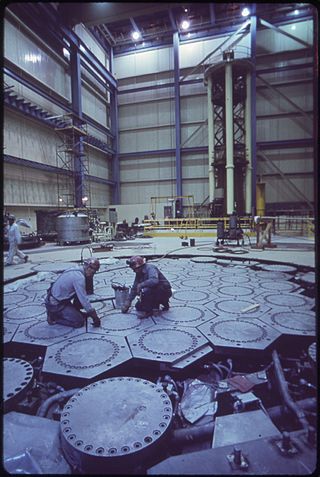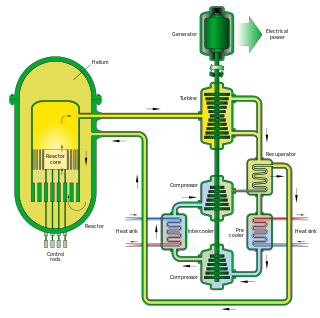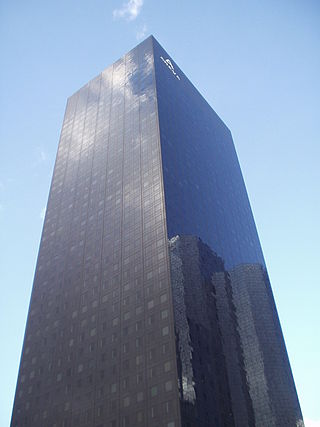Next Generation Nuclear Plant Project implementation
The NGNP, as a nuclear power facility design, is closely coupled with the United States Department of Energy (DOE) Next Generation Nuclear Plant Project (NGNP Project). The NGNP Project included participation by the DOE, Idaho National Laboratory, and the commercial utilities and reactor designers consortium NGNP Industry Alliance. [3] The United States Nuclear Regulatory Commission (NRC) engaged in pre-licensing interactions with DOE and INL on technical and policy issues that could affect the design and licensing of the NGNP prototype from 2006 until suspension of the effort in 2013. NRC interactions regarding the NGNP were docketed on NRC Docket PROJ0748. [4]
DOE and INL established the NGNP Project as required by Congress in Subtitle C of Title VI of the Energy Policy Act of 2005. The mission of the NGNP Project was to develop, license, build, and operate a prototype modular high temperature gas-cooled reactor (HTGR) plant that would generate high-temperature process heat for use in hydrogen production and other energy-intensive industries while generating electric power at the same time. The hydrogen production aspects of the project were closely aligned with then-President George W. Bush's goals for creating a US-led hydrogen economy. [5] As stipulated by the Energy Policy Act of 2005, pre-licensing activities for the NGNP prototype began with the development of the NGNP Licensing Strategy Report to Congress [6] that was jointly issued by NRC and DOE in August 2008. Subsequent NRC interactions with DOE and INL centered primarily on the NRC's review and assessment of a series of NGNP white paper submittals that describe the approaches that DOE and INL propose to pursue in establishing the technical safety bases and criteria for licensing the NGNP prototype. NGNP pre-licensing interactions began in 2006. [4] [7] [8]
The DOE issued in 2007 a "request for expressions of interest from prospective industry teams" [9] that want to provide design services for developing the NGNP.
With an earlier focus on South Africa's pebble bed modular reactor (PBMR), in 2012, INL approved a design similar to Areva's SC-HTGR (formerly "Antares") reactor as the chosen next-generation nuclear power plant VHTR to be deployed as a prototype by 2021. It was in competition with General Atomics' gas turbine modular helium reactor and Westinghouse' PBMR. [10] The NGNP Industry Alliance agreed with this technology vendor decision of the AREVA prismatic core modular HTGR in a steam supply configuration for initial applications for co-generation of process heat and electricity. [3]
Next Generation Nuclear Plant Project termination
On October 17, 2011, the Secretary of Energy forwarded to Congress the report and recommendations of a Nuclear Energy Advisory Committee review of the NGNP Project EPAct Phase 1 activities. The Secretary's letter concluded that “…Given current fiscal constraints, competing priorities, projected cost of the prototype, and the inability to reach agreement with industry on cost share, the Department will not proceed with the Phase 2 design activities at this time. The Project will continue to focus on high temperature reactor research and development activities, interactions with the Nuclear Regulatory Commission to develop a licensing framework, and establishment of a public-private partnership until conditions warrant a change of direction.” [11]
Pre-licensing discussions regarding the NGNP were suspended in 2013 after the 2011 DOE decision not to proceed into the detailed design and license application phases of the NGNP Project and continuing efforts to advance the project ended unsuccessfully. DOE's decision cited impasses between DOE and the NGNP Industry Alliance in cost sharing arrangements for the public-private partnership required by Congress. [4]
The overall project faltered in the mid-2010s due to a lack of pressing demand from industry and government stakeholders, and lack of funding commitment from both private and government sources. While the overall program made notable achievements in materials science and regulatory matters which saw further application, by 2015 the overall project was terminated without any fabrication or construction of a NGNP plant performed or planned. [12] [13]

Dry cask storage is a method of storing high-level radioactive waste, such as spent nuclear fuel that has already been cooled in the spent fuel pool for at least one year and often as much as ten years. Casks are typically steel cylinders that are either welded or bolted closed. The fuel rods inside are surrounded by inert gas. Ideally, the steel cylinder provides leak-tight containment of the spent fuel. Each cylinder is surrounded by additional steel, concrete, or other material to provide radiation shielding to workers and members of the public.

The Pebble Bed Modular Reactor (PBMR) is a particular design of pebble bed reactor developed by South African company PBMR (Pty) Ltd from 1994 until 2009. PBMR facilities include gas turbine and heat transfer labs at the Potchefstroom Campus of North-West University, and at Pelindaba, a high pressure and temperature helium test rig, as well as a prototype fuel fabrication plant. A planned test reactor at Koeberg Nuclear Power Station was not built.

Areva S.A. is a French multinational group specializing in nuclear power headquartered in Courbevoie, France. Before its 2016 corporate restructuring, Areva was majority-owned by the French state through the French Alternative Energies and Atomic Energy Commission (54.37%), Banque publique d'investissement (3.32%), and Agence des participations de l'État (28.83%). Électricité de France, of which the French government has a majority ownership stake, owned 2.24%; Kuwait Investment Authority owned 4.82% as the second largest shareholder after the French state.

Idaho National Laboratory (INL) is one of the national laboratories of the United States Department of Energy and is managed by the Battelle Energy Alliance. Historically, the lab has been involved with nuclear research, although the laboratory does other research as well. Much of current knowledge about how nuclear reactors behave and misbehave was discovered at what is now Idaho National Laboratory. John Grossenbacher, former INL director, said, "The history of nuclear energy for peaceful application has principally been written in Idaho".

High-temperature electrolysis is a technology for producing hydrogen from water at high temperatures.

The EPR is a third generation pressurised water reactor design. It has been designed and developed mainly by Framatome and Électricité de France (EDF) in France, and by Siemens in Germany. In Europe this reactor design was called European Pressurised Reactor, and the internationalised name was Evolutionary Power Reactor, but is now simply named EPR.
Generation IVreactors are nuclear reactor design technologies that are envisioned as successors of generation III reactors. The Generation IV International Forum (GIF) – an international organization that coordinates the development of generation IV reactors – specifically selected six reactor technologies as candidates for generation IV reactors. The designs target improved safety, sustainability, efficiency, and cost. The first commercial Gen IV plants are not expected before 2040–2050, although the World Nuclear Association in 2015 suggested that some might enter commercial operation before 2030.

A high-temperature gas-cooled reactor (HTGR) is a type of gas-cooled nuclear reactor which use uranium fuel and graphite moderation to produce very high reactor core output temperatures. All existing HTGR reactors use helium coolant. The reactor core can be either a "prismatic block" or a "pebble-bed" core. China Huaneng Group currently operates HTR-PM, a 250 MW HTGR power plant in Shandong province, China.

The gas-cooled fast reactor (GFR) system is a nuclear reactor design which is currently in development. Classed as a Generation IV reactor, it features a fast-neutron spectrum and closed fuel cycle for efficient conversion of fertile uranium and management of actinides. The reference reactor design is a helium-cooled system operating with an outlet temperature of 850 °C (1,560 °F) using a direct Brayton closed-cycle gas turbine for high thermal efficiency. Several fuel forms are being considered for their potential to operate at very high temperatures and to ensure an excellent retention of fission products: composite ceramic fuel, advanced fuel particles, or ceramic clad elements of actinide compounds. Core configurations are being considered based on pin- or plate-based fuel assemblies or prismatic blocks, which allows for better coolant circulation than traditional fuel assemblies.

Framatome is a French nuclear reactor business. It is owned by Électricité de France (EDF) (75.5%), Mitsubishi Heavy Industries (19.5%), and Assystem (5%).
Atmea was a joint venture between Mitsubishi Heavy Industries (MHI) and EDF Group set up in 2006 to develop, market, license and sell the ATMEA1 reactor, a new generation III+, medium-power pressurized water reactor (PWR). The company was headquartered in Paris. The joint venture was abandoned in 2019.

PRISM is a nuclear power plant design by GE Hitachi Nuclear Energy (GEH).

NuScale Power Corporation is a publicly traded American company that designs and markets small modular reactors (SMRs). It is headquartered in Portland, Oregon. A 50 MWe version of the design was certified by the US Nuclear Regulatory Commission (NRC) in January 2023.

Small modular reactors (SMRs) are a proposed class of nuclear fission reactors, smaller than conventional nuclear reactors, which can be built in one location, then shipped, commissioned, and operated at a separate site. The term SMR refers to the size, capacity and modular construction only, not to the reactor type and the nuclear process which is applied. Designs range from scaled down versions of existing designs to generation IV designs. Both thermal-neutron reactors and fast-neutron reactors have been proposed, along with molten salt and gas cooled reactor models.
GE Hitachi Nuclear Energy (GEH) is a provider of advanced reactors and nuclear services. It is headquartered in Wilmington, North Carolina, United States. Established in June 2007, GEH is a nuclear alliance created by General Electric and Hitachi. In Japan, the alliance is Hitachi-GE Nuclear Energy. In November 2015, Jay Wileman was appointed CEO.

The Office of Nuclear Energy (NE) is an agency of the United States Department of Energy which promotes nuclear power as a resource capable of meeting the energy, environmental, and national security needs of the United States by resolving technical and regulatory barriers through research, development, and demonstration.
Holtec International is a supplier of equipment and systems for the energy industry founded in Mount Laurel, New Jersey and based in Jupiter, Florida, United States. It specializes in the design and manufacture of parts for nuclear reactors. The company sells equipment to manage spent nuclear fuel from nuclear reactors.
A nuclear microreactor is a plug-and-play type of nuclear reactor which can be easily assembled and transported by road, rail or air. Microreactors are 100 to 1,000 times smaller than conventional nuclear reactors, and when compared with small modular reactors (SMRs), their capacity is between 1 and 20 megawatts whereas SMRs comes in the range from 20 to 300 megawatts. Due to their size, they can be deployed to locations such as isolated military bases or communities affected by natural disasters. It can operate as part of the grid, independent of the grid, or as part of a small grid for electricity generation and heat treatment. They are designed to provide resilient, non-carbon emitting, and independent power in challenging environments. The nuclear fuel source for the majority of the designs is "High-Assay Low-Enriched Uranium", or HALEU.














